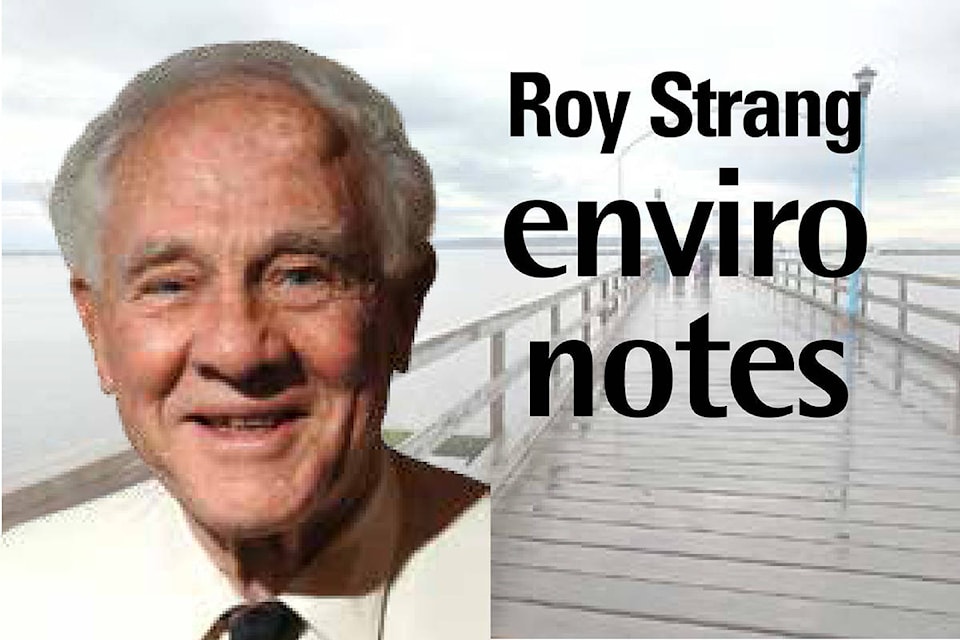South Surrey environmentalist Roy Strang retired from writing his Peace Arch News column, Enviro Notes, in 2015. He reached out last week to share these thoughts.
There’s no doubt that British Columbia is a forested province and, though there’s still some debate about causes, it’s also generally agreed that our climate is changing.
What do the impending changes mean for B.C’s forests in general and the Semiahmoo Peninsula in particular?
If forecasts are accurate, we can expect warmer temperatures, more erratic rainfall and less snow.
The impact on our forests has already been seen in the recent damaging outbreak of mountain pine beetles as one consequence of a change, which was brought about, at least in part, by a series of relatively mild winters – and now we’re suffering the worst fire season on record.
The tree line can be expected to rise in the mountains and northwards at the extremity of the boreal forest affecting timber productivity and allowable harvesting.
The increasing risk of forest fires will force municipal authorities to give more thought and attention to urban boundaries and the interface between sprawling housing development and the forest edge.
A changing climate will alter the make-up of plant species in many habitats to the detriment of creatures there today, some of them such as mountain caribou already endangered.
Local ski resorts will need to adjust to shortened winter sports seasons.
Trees that are struggling with adverse conditions will grow only slowly, so that they will give off less oxygen and store less carbon than healthy vigorous specimens and will be more susceptible to insect attacks.
These are largely province-wide challenges with little direct or immediate relevance to our communities, though they will have impacts.
Where do we fit in?
Landscapers and gardeners must accept that some of our beloved tree species – like the western red cedar – will not thrive in the expected future conditions.
If we must plant Douglas firs, then we should use the interior variety, which is better adapted to hotter drier weather than its coastal cousin.
Ponderosa pine, too, is another native species which survives well in our southern interior and so can be expected to do well in the new climate regime here.
We should not shy away either from looking southwards at some of their species and varieties which are flourishing inland and away from the coast where conditions may be a foretaste of our future. Is there a role for such Mediterranean species as the robust, long-lived olive?
We should ask ourselves, if small trees like dogwood, mountain ash (rowan, if you’re a Scot) and black mulberry will not be as efficient at providing greenery and leafy canopy as struggling firs and oaks.
Shrubs, too, can be valuable, and there are several native species to consider – hawthorn, hazel, Indian plum, ocean spray, Saskatoon berry, vine maple and willows are just a few of them. Recent research indicates that, since they grow at tail-pipe level, shrubs are better than trees at trapping vehicle exhaust fumes and toxins, so perhaps our boulevards should be lined with hedgerows instead of sentry-like rows of trees with their canopies far above ground level pollutants.
Surrey has at least two water-wise gardens demonstrating planting make-up suitable for warmer, drier conditions. How far will our nurseries and garden stores go to lead gardeners away from conventional or fashionable stock to more advanced and innovative plantings? Could our municipal gardens provide leadership and minimize their watering requirements by planting only drought-tolerant species and varieties?
A lawn needs only about two centimetres – that’s less than an inch – once a week to keep it healthy through a dry summer; in other words, deep, infrequent watering is the optimal routine.
Let’s heed King Canute and, instead of trying to halt the naturally inevitable, learn to adjust and live with a changing climate.
Dr. Roy Strang used to write weekly on environmental issues, prior to retirement.
